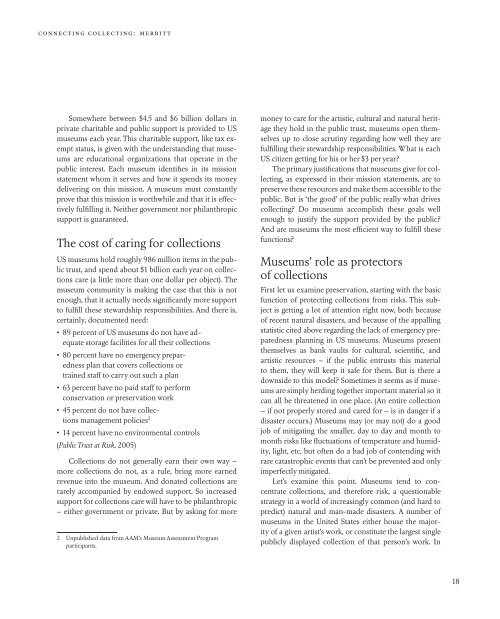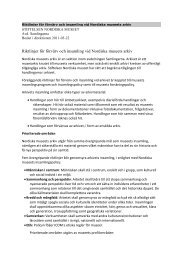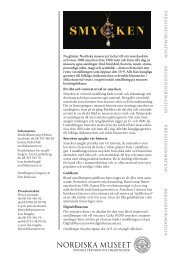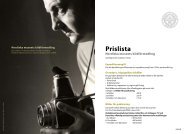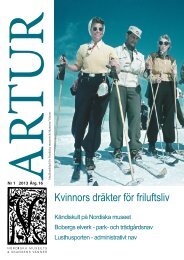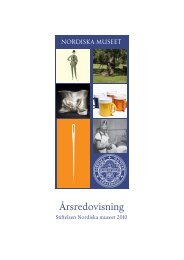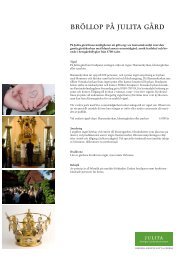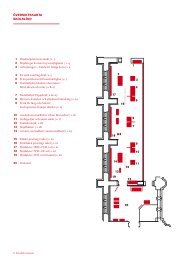Samdok - Nordiska museet
Samdok - Nordiska museet
Samdok - Nordiska museet
You also want an ePaper? Increase the reach of your titles
YUMPU automatically turns print PDFs into web optimized ePapers that Google loves.
connecting collecting: merritt<br />
Somewhere between $4.5 and $6 billion dollars in<br />
private charitable and public support is provided to US<br />
museums each year. This charitable support, like tax exempt<br />
status, is given with the understanding that museums<br />
are educational organizations that operate in the<br />
public interest. Each museum identifies in its mission<br />
statement whom it serves and how it spends its money<br />
delivering on this mission. A museum must constantly<br />
prove that this mission is worthwhile and that it is effectively<br />
fulfilling it. Neither government nor philanthropic<br />
support is guaranteed.<br />
The cost of caring for collections<br />
US museums hold roughly 986 million items in the public<br />
trust, and spend about $1 billion each year on collections<br />
care (a little more than one dollar per object). The<br />
museum community is making the case that this is not<br />
enough, that it actually needs significantly more support<br />
to fulfill these stewardship responsibilities. And there is,<br />
certainly, documented need:<br />
• 89 percent of US museums do not have adequate<br />
storage facilities for all their collections<br />
• 80 percent have no emergency preparedness<br />
plan that covers collections or<br />
trained staff to carry out such a plan<br />
• 63 percent have no paid staff to perform<br />
conservation or preservation work<br />
• 45 percent do not have collections<br />
management policies2 • 14 percent have no environmental controls<br />
(Public Trust at Risk, 2005)<br />
Collections do not generally earn their own way –<br />
more collections do not, as a rule, bring more earned<br />
revenue into the museum. And donated collections are<br />
rarely accompanied by endowed support. So increased<br />
support for collections care will have to be philanthropic<br />
– either government or private. But by asking for more<br />
2 Unpublished data from AAM’s Museum Assessment Program<br />
participants.<br />
money to care for the artistic, cultural and natural heritage<br />
they hold in the public trust, museums open themselves<br />
up to close scrutiny regarding how well they are<br />
fulfilling their stewardship responsibilities. What is each<br />
US citizen getting for his or her $3 per year?<br />
The primary justifications that museums give for collecting,<br />
as expressed in their mission statements, are to<br />
preserve these resources and make them accessible to the<br />
public. But is ‘the good’ of the public really what drives<br />
collecting? Do museums accomplish these goals well<br />
enough to justify the support provided by the public?<br />
And are museums the most efficient way to fulfill these<br />
functions?<br />
Museums’ role as protectors<br />
of collections<br />
First let us examine preservation, starting with the basic<br />
function of protecting collections from risks. This subject<br />
is getting a lot of attention right now, both because<br />
of recent natural disasters, and because of the appalling<br />
statistic cited above regarding the lack of emergency preparedness<br />
planning in US museums. Museums present<br />
themselves as bank vaults for cultural, scientific, and<br />
artistic resources – if the public entrusts this material<br />
to them, they will keep it safe for them. But is there a<br />
downside to this model? Sometimes it seems as if museums<br />
are simply herding together important material so it<br />
can all be threatened in one place. (An entire collection<br />
– if not properly stored and cared for – is in danger if a<br />
disaster occurs.) Museums may (or may not) do a good<br />
job of mitigating the smaller, day to day and month to<br />
month risks like fluctuations of temperature and humidity,<br />
light, etc, but often do a bad job of contending with<br />
rare catastrophic events that can’t be prevented and only<br />
imperfectly mitigated.<br />
Let’s examine this point. Museums tend to concentrate<br />
collections, and therefore risk, a questionable<br />
strategy in a world of increasingly common (and hard to<br />
predict) natural and man-made disasters. A number of<br />
museums in the United States either house the majority<br />
of a given artist’s work, or constitute the largest single<br />
publicly displayed collection of that person’s work. In<br />
18


